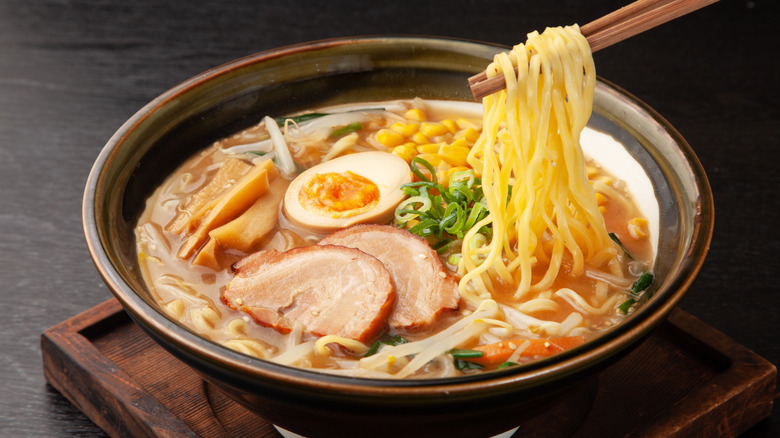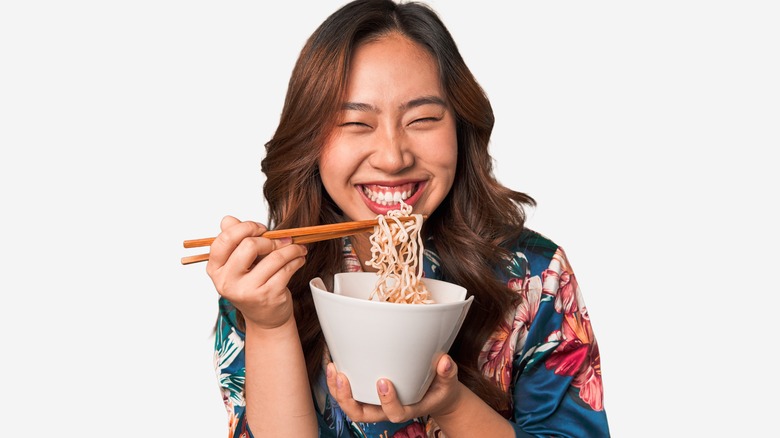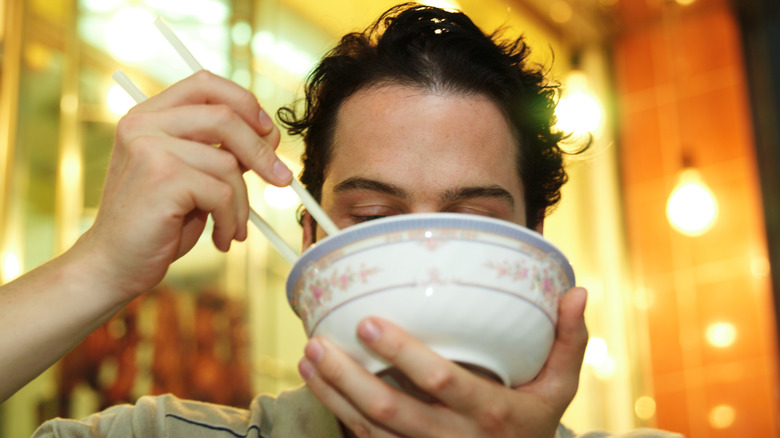The Reason Slurping Is Part Of Proper Etiquette In Japan
A lot of people remember slurping up their noodles as a kid, whether they were in spaghetti or a bowl of chicken noodle soup. The goal was to do it as quickly as possible, to get maximum wiggliness out of the noodle. Bonus points if you ended up with sauce or broth all over your face. Inevitably, if you grew up in the U.S., one or both parents would tell you to quit it, calling it "rude." Perhaps it's bad manners in America, but this is not the case in Japan. It's not unusual to see people of all ages in Japan happily and noisily slurping up their noodles or soup. It doesn't equate to bad table and social manners, in fact, the sounds of slurps tell the host that you're enjoying your meal.
There are a lot of opportunities to slurp your food in Japan. Japanese cuisine includes many soups, and a lot of signature noodles like udon, soba, and ramen. Just think of all those times you were told to hush as a kid when you ate; order a big bowl of delicious noodles, slurp away with everyone else, and make up for lost time.
If you want to enjoy your meal to the fullest, slurp away
Acknowledging the talent of your host or chef by slurping your noodles is a fine enough reason to be noisy while you eat but the practice is also for the eater's benefit. For one, a bowl of noodle soup is often served hot and one way to eat it up right away is to take in a lot of air when you place the noodles in your mouth. So, by slurping, you're essentially cooling the food down as it enters your mouth. That said, slurping should also be employed when you're eating cold noodles. With hot or cold noodles, you want to take in as much flavor as possible and by slurping, you're breathing in the aromas and letting every flavor roll around in your mouth. It's a lot like wine tasting, when you think about it.
Japanese food is known for its precision in the way it's prepared and presented. Noodles are often hand-made with care to create perfect texture and flavor. Many broths for soup are homemade and take hours of simmering to create the best flavor. Finally, the flavorings are well-balanced, all for the sake of the person dining. For the full flavor experience, slurping is not only encouraged, but necessary.
Other important etiquette dining tips in Japan
Slurping up your soup and noodles in Japan can be viewed as an easy and very enjoyable way to practice table manners but there are some other etiquette rules you should take note of. You will most likely be eating noodle dishes with chopsticks, which should be used properly. For example, don't point at something or someone with them, don't rub chopsticks together, or otherwise play with them. Remember, they are eating utensils. To drink the soup that your noodles are resting in, either sip it with the ceramic spoon you're given or sip the broth from the bowl by lifting it to your mouth.
When you are finished eating, it's customary to say to your host or chef, "gochisōsama deshita," which means: "Thank you for the feast." If you have been eating with disposable chopsticks, place them in the paper or plastic wrapping they came in or rest them on your chopstick rest, if you were given one. If not, place them sideways across your bowl, not pointing away from you. Finally, call your parents and tell them how loudly you just ate and how much you enjoyed it.



